Anthropologist to friend – the journey of Madhumala Chattopadhyay who first contacted the Sentinelese and Jarawas in Andamans.
On 4 January, 1991, more than 1,200 kms from the Indian mainland in the Bay of Bengal, a young Indian woman anthropologist waded waist-deep into the coral reefs to hand over a coconut to a man from the Sentinelese tribe. This was the first-ever friendly contact with this hostile tribe of the Andamans.
Perhaps no people on earth remain more genuinely isolated than the Sentinelese, one of the few un-contacted people in the world, who have lived in the North Sentinel Islands of the Andamans for the last estimated 60,000 years, shunning any contact with the outside world. Their antiquity, traced to the Palaeolithic age, makes them the first inhabitants of India. There have been many attempts previously to establish contact with the Sentinelese, which however failed with contact parties being received with arrows, some even finding their mark. Given the hostile nature of the Sentinelese, the contact parties would avoid approaching the tribe directly and watch them from the safety of their ships or leave gifts in remote part of the island.
This was the first time a woman was a part of a contact expedition with the Sentinelese, and they put their guard down. The presence of a woman indicated that the contact party meant no harm. This braveheart anthropologist is Dr Madhumala Chattopadhyay, then a researcher (initially a fellow and subsequently research associate) with the Anthropological Survey of India, who went on to spend six years researching the various primitive tribes of the Andaman and Nicobar Islands. Madhumala is also the first woman to be accepted by another Andaman tribe, the Jarawas, with whom she established a friendly relationship, especially the women folk. Unfortunately, her accomplishments remain forgotten.
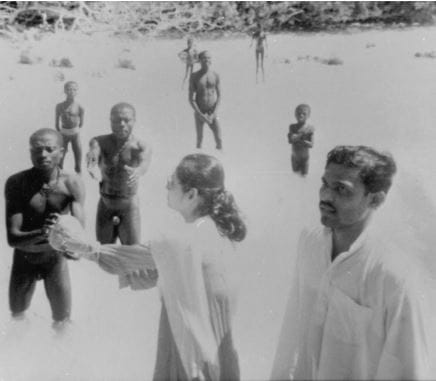
Madhumala now works in the mid-level bureaucracy of a central government ministry in Delhi handling routine government files, an unseemly situation for a woman who built our first bridge to an unknown world. Madhumala does not wear her success on her sleeve, and is humble to the point of being reticent. Her book Tribes of Car Nicobar and journal papers remain standard reference texts in universities worldwide. We at Probashionline.com met Madhumala and heard her incredible story. She concluded by saying, “Never ever in my six years of doing research alone with the tribes of Andamans did any man ever misbehave with me. The tribes might be primitive in their technological achievements, but socially they are far ahead of us”. We could not but agree.
An anthropologist’s wish
A twelve-year-old girl one morning in her home in Shibpur, Howrah, a suburb of Kolkata, happened to chance upon a small news item in The Telegraph newspaper, which informed of the birth of a baby amongst the almost-extinct Onge tribes of the Andamans. Excited, the girl ran to her father, an accounts officer with the South Eastern Railway, and demanded that on their next vacation they visit the Onges’. Her father in order to brush off his pestering daughter remarked that only a researcher or a journalist is allowed to visit the tribes of the Andamans. This remark stuck and the little girl, Madhumala, was subsumed with the thought of becoming a researcher. The rigour and the hard work of being a field anthropologist – a branch of science which studies primitive tribes – was far from her mind. The romance and adventure of an unknown world beckoned this young girl.
After completing her schooling from Bhabani Balika Vidyalaya, Shibpur, at the top of her class, Madhumala took admission in BSc (Hons) Anthropology, University of Calcutta. At the university admission counter, Madhumala had enquired which department dealt with the study of tribes and was informed it was anthropology. Back home, her parents were a bit disconcerted with their eldest daughter taking up anthropology. They enquired “what on earth is anthropology?”, to which Madhumala had replied, “this is my passport to the Onges”. Knowing how stubborn and steadfast their daughter could be, her parents did not object despite not being entirely convinced.
Also read: What’s Christianity to those who pray to sky & sea, says first woman to contact Sentinelese
After a brilliant academic track record as an undergraduate and a post-graduate student, including a seminal dissertation on “Genetic Study among the Aborigines of the Andaman”, Madhumala applied for a PhD fellowship to the Anthropological Survey of India for doing field research with the tribes of the Andamans. The committee tasked to decide on the fellowship demurred — the prevalent notion being that it was not safe for a woman researcher to do field work amongst the tribes. However, Madhumala’s impeccable academic record, her previous research work and a sterling approach paper for the fellowship was hard to overlook. So, a way was proposed by the fellowship committee: Madhumala would be allowed to work in the Andamans on an Anthropological Survey of India fellowship if Madhumala’s parents were to sign an undertaking that if anything untoward happened to their daughter while doing research amongst the primitive tribes, including loss of life, Anthropological Survey of India was not to be held responsible. It is to the credit of Madhumala’s mother Pronoti Chattopadhyaya (her father being no more) that she signed the dotted line fully aware of the dangers involved, refusing to let her daughter’s childhood dream go unfulfilled. Little was it known then that Madhumala would go on to create history.
Madhumala for the next six years would continue to research the various tribes of the Andamans, which had in store many startling events and stories, some of which we will allude to in this article. Let’s fast track to the most seminal work done by Madhumala i.e. the first human contact with the Sentinelese.
The Sentinelese
Perhaps no people on Earth remain more genuinely isolated than the Sentinelese. They, to date, resist outsiders and are prone to attacking them. In 1880, a heavily-armed British expedtion led by Maurice Portman landed on North Sentinel Island and made what is believed to be the first exploration of the island by outsiders. Several days passed before they made contact with any Sentinelese. An elderly couple and four children were captured and brought back to Port Blair. While the elderly couple died in captivity, the four children were given gifts and released back to the Sentinel Islands, never to be seen again. The British did not pursue any further expedition to this island.
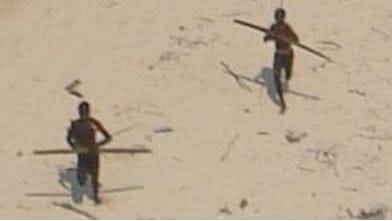
Small contact parties sent by the Anthroplogical Survey of India in the early 1970s were turned away with arrows. A documentary team from the National Geographic accompanied under police protection got the same fierce welcome in 1974. The documentary was interestingly titled ‘Man in Search of Man’. The film’s director took an 8-foot-long arrow in the thigh.
Contact
On 4 January, 1991, MV Tarmugli, the Andaman Nicobar Administration ship, put down its anchor off Allen point on the southwest part of the North Sentinel Islands. The purpose was to attempt a friendly contact with the Sentinelese. Not much was expected, probably like many futile missions in the past, this would also to go down in the file as another wasted attempt. However, unlike in the past, this mission had one difference, there was a women anthropologist in the contact team. At around 8 am in the morning, the team of 13, including Madhumala, set sail for the island in a small craft. The key team members were team leader S. Awaradi (director, tribal welfare, A&NI administration), medical officer Dr Arun Mullick (for providing medical attention in case of sickness or injury) and anthropologist Madhumala Chattopadhyay. The rest were support crew.
Also read: Should Sentinelese tribe be isolated for safety or unfair to treat them as museum displays?
As the craft approached the island, three huts came into view. The dreaded Sentinel Island, Madhumala had read so much about, was now in front of her. As the boat inched closer to the shore, Madhumala’s heart beat went up a notch — will the tribe show up? However, the shore looked deserted. Seeing smoke coming out from another part of the island, the contact party steered their boat towards that direction. Suddenly, the Sentinelese were there behind the trees — the most secluded tribe in the world had come into view. Most were men, four of them armed with bows and arrows.
It was now up to the contact team to take initiative, and they started dropping coconuts in the water, which they had brought with them. Then something that had never been seen before happened. After a bit of trepidation, a few Sentinelese men came sprinting and waded through the shallow continental shelf to collect the floating coconuts. The team was awestruck; the Sentinelese had accepted a friendly gesture. The team leader instructed that more coconuts be dropped, and this time the Sentinelese brought a canoe to collect the coconuts in cane baskets. The women and children, however, maintained a distance and remained on the shore. An invisible wall stood between the islanders and the contact team. No party made the first move to bridge the gap further. Four hours rolled by, the contact party kept floating coconuts and the Sentinelese kept collecting them. Perhaps this was the farthest that the Sentinelese would go.
With their stock of coconuts over, the team went back to the ship to replenish. It was 2 pm when the team returned. The process of dropping coconuts started again, and this time the tribe welcomed the contact party with shouts of “Nariyali jaba jaba”. Madhumala recognised this cry to mean “more and more coconuts”, a distinct Onge dialect, given her knowledge of a number of Andamanese languages. The Sentinelese in the second round had become bolder. A young Sentinelese youth waded up to the boat and touched it with his hands. Following him, more men closed in to collect the coconuts.
In this moment of ice-breaking, a Sentinelese youth who was sitting on the shore got up and aimed his arrow at the contact party. Fazed but not betraying fear, Madhumala gestured at the youth to come over and take his share of the coconuts. This was a moment of standoff — Madhumala refusing to remove eye contact and the arrow refusing to go down. The arrow was released but Providence intervened. As the marksman was about to release, a Sentinelese woman standing nearby gave a push to the marksman, and the arrow missed its mark and fell harmlessly in the water. The woman had done that on purpose, thus saving the contact party from severe injury or even death.
Undeterred, the team persisted. It was now the turn of the Sentinelese to be surprised. The contact party, including Madhumala, decided to jump into water. Knee-deep in water, the space-age man (woman) was looking eye-to-eye with one of the most primitive people on earth. It was not a meeting with a finger on the trigger or with a bow string pulled, it was a meeting between equals, with dignity and respect. The coconuts were not being floated in the water anymore, but were being handed over in person. This was the making of anthropological history.
A woman in their midst
What probably changed the equation on that fateful day was the presence of a woman in the contact team who maintained her calm and took the initiative. A woman in the contact party indicated to the Sentinelese – who are extremely protective of their women – that the boat people meant no harm. For a brief moment, the Sentinalese let their guard down, and allowed outsiders into their world.
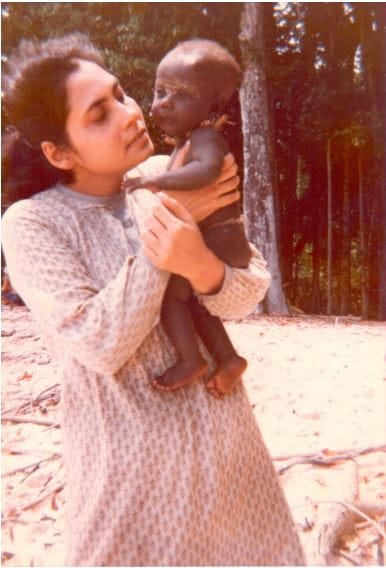
Madhumala came back to the North Sentinel Islands as a member of another contact party on 21 February, a month-and-a-half after the first contact. This time the welcome was enthusiastic. The Sentinelese climbed up on the boat to receive the coconuts. Thankfully, no arrow was aimed.
Seclusion
While the ice with this hostile tribe was on the verge of being broken, the government of India decided to stop any more contact with the Sentinelese, even for academic purposes. It was feared that outside contact might introduce diseases in the tribe. A justified move given the epidemics introduced by outside contact in other tribes of the Andamans. Today, the Sentinelese remain secluded and hostile despite the early contacts made. The 2011 census of this tribe was done from a distance of 1.5 kms from the seashore through observation, given the risks involved in sending enumerators ashore. As recently as 2006, two fishermen who had strayed close to the shores of North Sentinel Islands were killed by the Sentinelese. The government of India enforces a 3 mile no-entry zone around these islands.
Also read: John Allen Chau ‘lost his mind’, was aware of dangers of North Sentinel Island, say friends
The Jarawas
Madhumala continued her research for many more years in the Andamans, primarily with the Jarawa tribe. The first friendly contact with the Jarawas had been made in 1975 by a joint team from the Anthropological Survey of India and the A&NI Administration. Since then, systematic contacts were made by administration, who took bananas, coconuts etc. as gifts. However, there were instances of hostile reactions from the tribe, and authorities had banned inclusion of women in contact parties.
In 1991 when Madhumala went, she was the first woman from outside to visit the Jarawas. As a precaution, Madhumala remained in the motor boat while the men went ashore to meet the tribe. Seeing Madhumala, the Jarawa women began to gesture her to come ashore with the shout “Milale chera (friend come here)”. They started an impromptu dance to express their joy at seeing a woman in the contact team. This unexpected welcome from the Jarawa women for Madhumala prompted the team leader to send for the boat to bring Madhumala ashore.
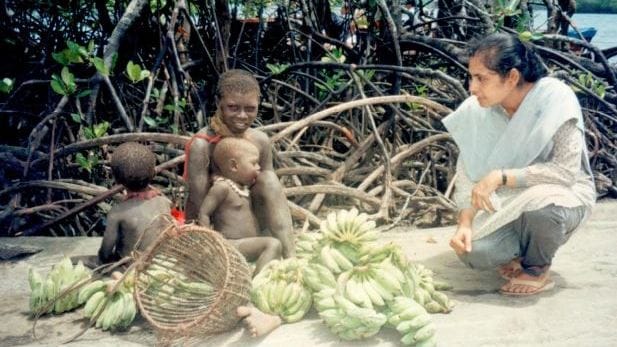
As the boat neared the shore, five Jarawa men climbed on to the boat and sat across Madhumala looking at her with curiosity. Heart beating hard, Madhumala maintained her composure. Other members of the contact team were not sure how to react; a wrong move could have been disastrous. It was at this juncture that a Jarawa woman climbed onto the boat and sat besides Madhumala. The Jarawa woman gestured to the five men that the visitor like her was a woman. Madhumala embraced the woman, which signified a gesture of friendship. No anthropology text book had taught her this, it came from experience, empathy and a sense of self preservation. The Jarawa woman was thrilled at this gesture and made all the five Jarawa men lie down on the floor of the boat like admonished children.
On landing, other Jarawa women surrounded Madhumala and started examining her skin texture and long hair with their fingers. The inspection involved pinching and scratching, which had to be endured to earn lasting friendship. Satisfied, the women offered Madhumala a hair band and an arm amulet as a token of acceptance in the community. With the initiation ceremony over and Madhumala getting a friendly welcome, she became a regular visitor to the Jarawa territory. Her anthropological research with the Jarawas was mainly through observation. No sophisticated instruments could be used since the Jarawa had a propensity of claiming things which Madhumala brought as their own, including the pencils which Madhumala used for taking notes.
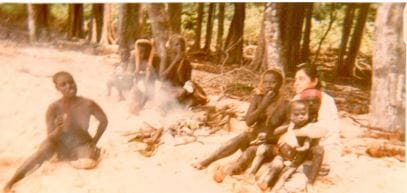
An interesting bond developed, and the Jarawa women would keep the Jarawa men at bay from Madhumala. She would be invited to the Jarawa huts, play with the children, share their food and sometimes be asked to even lend a hand with the household chores. Madhumala also became the resident doctor and would apply ointments to the injuries that the Jarawas would get with during their forays into the jungle for hunting and gathering. Despite her requests, the administration refused to give Madhumala permission for night stay with the Jarawas. The visits revealed to the Jarawas the modern man (woman), as much as it revealed to Madhumala about the Jarawas.
Also read: It’s practically impossible to recover body of American killed by Andaman tribe: Police
The Debotobeti
Madhumala also did seminal work with the Onges’ and the Car Nicobarese. Amongst the Onge tribe, Madhumala was known as Debotobeti (doctor), because her anthropological research entailed checking the health status of the Onges, including taking of blood samples. Many years later, when at the request of the government of India, Madhumala accompanied then secretary for social justice and empowerment, Asha Das, to the islands, the Nicobarese recognised Madhumala and told the secretary that their daughter had come back.
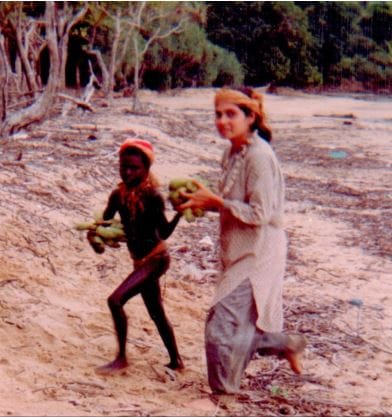
Given her seminal work, universities including University of Cornell and University of California, Berkley offered Madhumala research positions. However, her responsibilities towards her two younger siblings and aging mother kept her from taking up these assignments. She took up a regular job with the ministry of social justice and empowerment, where she is now employed as a senior research officer.
The government colony in Laxmibai Nagar in New Delhi where she lives is orderly and predictable, far from the verdant surroundings of the Andamans where every turn revealed something new. Her work remains forgotten. Ruth Benedict the famous anthropologist said “the purpose of anthropology is to make the world safe for human differences”. Madhumala has been true to her professional training.
This article was originally published on Probashionline






She’s a strong woman, looking forward to seeing the video about her.
What government fails to see is there are childrens who dont take education in that tribe and ruin their life,
Really glad to come across such a person who have been so focused and made it like this. Hope she is able to continue as we need more people like her. What baffles me here is discussion on authenticity of few pics by few people than just simply seeing the work done which deserves kudos! Let’s appreciate the power of a human connect.
an indeed beautifully written article about the daring, sensible woman and her exceptional work which i dont see being repeated ever again..truly remarkable..hats off..sad to note however, that such a worker is being neglected grossly..
That’s great M.chattopadhyay. I salute you to excavate the anthropological knowledge from danger island??.
Thanks for enrich my anthropological knowledge about other world? of the people.
Salute to The Print for bringing out this story . Pearls nesting in shells have no value unless exposed .The Print has brought out the story of a diamond.Kudos.
We need to recognize Madhumalas work in a big way so that kids are inspired to have a curiosity and chase their dreams with determined minds.
When I was in SJ&E 2012, I met Dr. Madhumala Chattopaadhyaay, Senior Research Officer at SJ&E. She has a very plesant personality, a kind hearted woman with simplicity. She is very humble n brave woman. I salute to Dr. Madhumala Chattopaadhyaay for her achievements n great work
Interesting to know about her and her acheivements! It calls for greater awareness about her work so that more about her experiences and knowledge can come in the public domain. Very intriguing tribes!
I doubt about degree of correctness of content. In one pic they showed her standing on shore n offering coconut to Sentinalese. Whereas if u hv seen videos n TV interviews of those anthropologists who visited that day, they were always in their boat, they were not invited on the shore which is clearly told in TV interview and there was no woman on boat. There was always a safe distance and hand to hand passing of coconut never happened (except one sack full of coconuts). Also, in article it’s told she recognized few words spoken by them like more n more coconut, where it’s clear that anthropologists are not sure about a single word if their language n they were using laha for coconut just on a trial basis hoping they understand jarawa word. Perhaps the pic is for jarawa tribe interaction, but the article is clearly misleading.
Sir, as an author of this article, I completely stand by what is written, the photographs are authentic and there has been no falsification of what transpired as narrated by Dr. Madhumala. There is no reason to falsify facts, for there is nothing to gain from it. I assure you Sir, this is a true account and that Dr. Madhumala is indeed a very brave lady and extremely humble who is the last person to wear her success on her sleeve and falsify any incident. The account related to in the article happened in 1991, and was one of the many attempts made by ASI to establish contact in those days before GoI prohibited any such expeditions. According to Dr. Madhumala, there is some similarity in the dialect of the tribes and Dr. Madhumala’s familiarity with the Onge dialect helped her to decipher some of the words she heard from the Sentinelese.
While there is no reason to doubt this story, the hallmark of good journalism is also corroboration and verification. Did you accept Dr. Chattopadhyay’s story of events at its face value or did you also verify it by cross checking her story with her then colleagues at ASI or any other external source?
Cant imagine how some people cant resist dissecting everything with their intellect and to mine out short comings with a narcisist intent.
Common readers like us can only sympathise with pseudo intellects like you Mr. Chaudhuri…
i am still working in the Jarawa area u der Tribsl Welfare departmnt in andaman…seen files and snaps too..all are part of periodical contact expedition being conducted by the Andaman administrstion among a particular group of Jarawas at certain territorial pockets such as Lakralungta, Foul Bay etc.in 70s and the team was phyisically led by one Shri Bhaktawar Singh, who was the man to befriend the Jarawas..while on the expeditious route the team used to visit the shallow water of North Sentinel Island to drop gifts like dehusked coconuts and iron materials. The team never succeeded to contact the sentinelese even in hand shake distance…the snaps posted here are of Jarawas and not the Sentinelese…After the US based tourist John Allen Chau was killed by the Sentinelese there has been an inflow of such news only to gain publicity by certain writers…Smti Madhumala was just part of the contact expedition team and the Jarawa group was already befriended and were contacted in the expeditions prior to Madhumala’s visit…nothing new
You are absolutely right ; I have not seen a single picture of this lady with the sentinalese people. More over , had she been really in contact with the sentinalese in 1991 , she would passed all the microbes and viruses like flu.
This is what has happened to native americans in West Indies by unknowing europeans
Your comments refer to incidents in the 70s while the article talks about Madhumala’s interaction with the indigenous groups in 1991. You seem to have missed the point!
जहां चाह है वहां राह है,। डा, मधुमाला चट्टोपाध्याय के स्वप्न और उसे साकार करने की कथा बहुत,प्रसशनीय और प्रेरणादायक है । आज की पीढ़ी को इसे अवश्य पढ़ना चाहिए। लेख के लेखक सुदीप्त सेन गुप्ता और प्रिट के सम्पादक को साधुवाद।
असली काम करने वाले ,प्रचार,प्रसार से दूर रहते हैं ,और सरकारी मशीनरी भी अपनी रफ़्तार से इन महत्वपूर्ण भूमिका निभाने वालो को नेपथ्य में डाल कर अपनी इतिश्री समझ लेती है। न वो अमरीकी घुसपैठीया नागरिक अंडमान निकोबार द्वीप समूह में मारा जाता , न, ही डा मधुमाला चट्टोपाध्याय की मेहनत की कहानी सामने आती।
इसी सन्दर्भ में एक और कहानी भी ,,एक पंडित जी,,नाम भूल गया के नाम से एक चैनल पर आती थी ,जिसमें उनके भी किसी दावे का विवरण था। अब हमें याद नहीं।खैर!
प्रबुद्ध पाठकों ,से आग्रह रहेगा की डा , मधुमाला चट्टोपाध्याय की कहानी को जितना प्रसारित किया जाये, उतना ही हमारी पीढ़ी की बेटीयों को इस तरह के काम हाथ में लेने के लिए प्रेरणा मिलेगी।
लेखक और सम्पादक से भी आग्रह रहेगा की डा, मधुमाला चट्टोपाध्याय से सम्बंध स्थापित कर उनकी सहमति मिलने के उपरांत जितना भी प्रचार,प्रसार लेख व चित्रों द्वारा किया जा सकता है अवश्य करें,एक तो उनके कार्य के प्रति सम्मान होगा, दूसरे श्री पीढ़ी के लिए प्रेरणास्रोत।
आप सब की प्रतिक्रिया और सहयोग के लिए अग्रिम बधाई।
धन्यवाद।
Truly inspiring story of a woman who has shown passion and dedication to follow her dreams, has been sensitive to understand and appreciate hitherto unknown culture of secluded tribes and is equally devoted to her elderly parents and younger siblings. Hats off to Dr. Madhumala. It’s a matter of pride for India.
Government of a India should recognise her efforts and give her chance and financial support to continue her research and enlighten world with her first hand knowledge on this subject.
It was definitely a good reading about Dr.Madhumala’s work in brief.having read some of the earlier writers of the nature like Verrier Elwin and others I am confident that she would have done more lasting work in the field of her choice.But the government’s as they are always put shacke ls of sorts.It is also possible that professional jealousy also played some part in preventing her from field resaerch.
It is not too late. She should be given all help to write her experiences with the tribes their social life. Government should encourage her.
Remarkable. I salute Dr. Madhumala Chattopadhayay.
She is really great and brave woman.
Very informative, interesting and inspiring story.
Dr madhumala deserves a standing ovation.
May God bless my country with such humble workers and at the same time may preserve purity of secluded tribes.
Madhubala, even though long years has passed in the meantime, may be allowed to again attempt contacts with the A and N tribes
Incredible story of an incredible woman Full thumbs up for her groundbreaking work with the tribals of andaman especially the dreaded and endangered sentinelese.
She is a true friend of the tribes. Thanks for bringing out her immense contribution in this field. I wish to hear her opinion in the recent incidentally with the Sentinelese.
Awesome article!!!Great work
Good article and Research by the person.
My only worry is today’s social media.
People will now dare to contact those people again.
Such cross-cultural interactions say much about both sides. Perhaps we are not as intelligent as we think we are, given our “modern” culture’s bias against women. It’s not surprising that the authorities organizing these efforts failed to assemble an investigative group comprised of an equal number of both men and women (or mostly women), which might have been interpreted by the Sentinelese as non-threatening outreach by another community (whereas an all-male group could be interpreted as a potentially hostile war party). The question I’d like to ask these organizing authorities is, if the presence of a woman reduced hostilities and increased the quality of information-gathering, why did they restrict Madhumala’s movements rather than give her more latitude? Why did they not add more women to the mission?
Dr. Chattopadyhay is an inspiration. I’ll be searching for her writings….
जहां चाह है वहां राह है।
यह कहती हैं कहानी।
सरकारी व्यवस्था और पल्ला झाड़ने वाली मशीनरी पर भी चोट करती है यह कहानी,जिसे कभी भी शायद प्रकाशित किया गया हो।
She is great ..and Dare to go there
Thanks for being a Link between them and us
A fascinating article about a brave and intelligent woman. I hope that at some point in time she may decide/feel that her family circumstances allow her to return to anthropological research in the field. Experience and talents such as her should be used.
I believe using the term primitive to refer people is a punishable offence.
Primitive is not a bad word. It could be a civilisation, cohesive social group which has no known written or codified law, rule book of governance, justice and administration.
This article is nice & really well-written. Still, despite an elaborate account on how this courageous , inquisitive and research-oriented anthropologist was able to successfully interact with one of the world’s most ‘un-contacted’ and hostile tribes in the archipelago over a period of years, this narrative somehow misses to enlighten the readership how she was able to carry on conversation with the womenfolk during her frequent trips to study their workaday life as a social unit and the exact findings she arrived at on their collective thinking on life in general as lived by them. It’s also not clear if she had attempted to convince them into dispelling notions of their inherent hostility to outsiders visiting their shores every now and then for establishing camaraderie and promote their wellbeing in the context of universal fellowship.
If only these islanders had imbued and remembered her advisory to act friendly the recent killing of an American missionary wouldn’t have been planned and executed the way it panned out.
With this just being an article, they can’t cover all of her findings or experience. They did, however, mention the books and reports she wrote with that information so that we could delve deeper. I am also very interested in learning more about her experience!
Let it be known to her that she has earned many admirers of her work and love of humanity. Salutes, maa’m.
Really inspiring! Madhumala is a real anthropologist, very kind human being!
Very inspiring and interesting story. Hats off to Dr. Madhumala. My Good wishes to her.